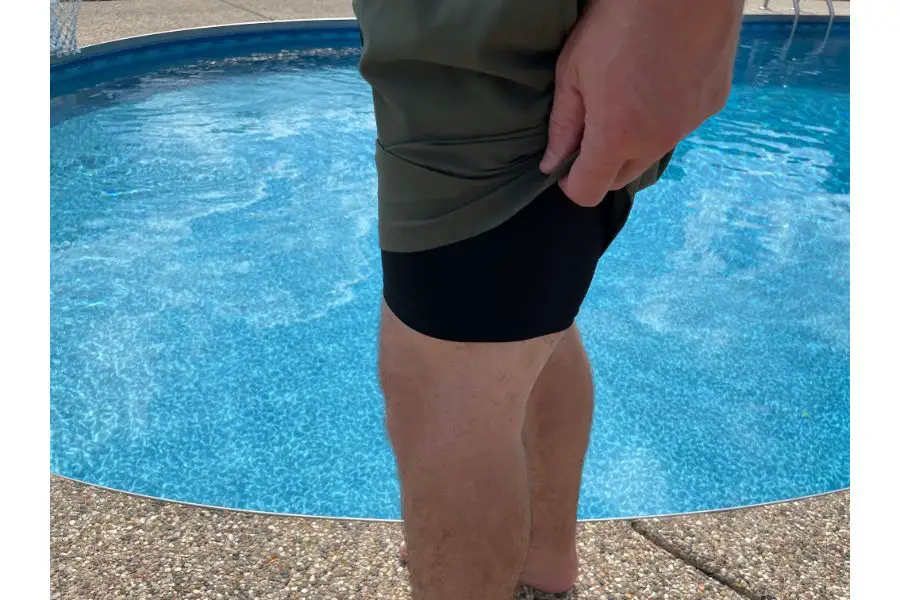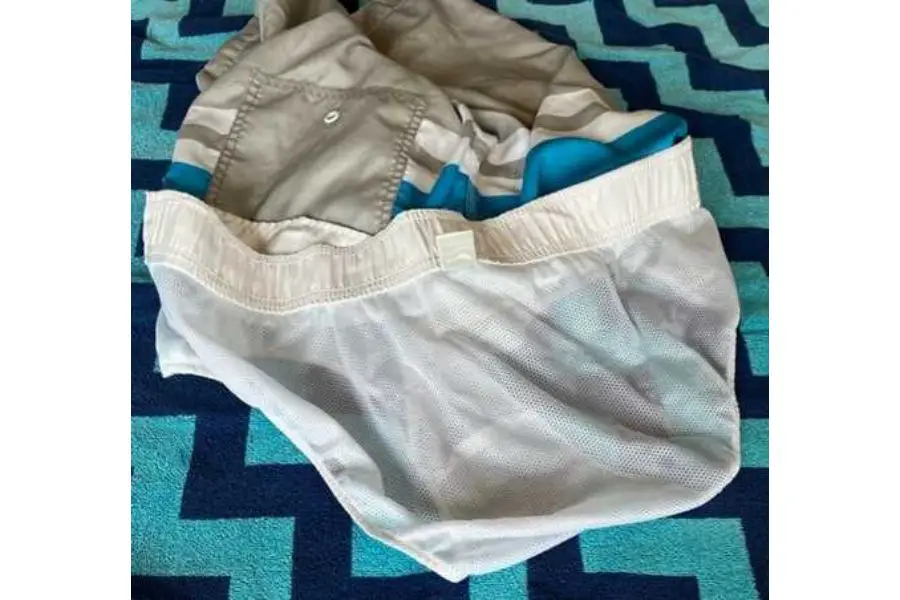Why do swim trunks have mesh lining? It’s a phrase often muttered by someone experiencing discomfort caused by ill-fitting netting.
While there are many types of swimwear out there for men, only some have liners. Here are a few of the more popular swimwear types:
Swim Trunks
These are designed to look and fit like typical shorts. They often include an elastic waistband with a drawstring to help keep them snug on the waist. Swim trunks often have a liner embedded.
Board Shorts
These were originally designed with surfers in mind, but have also become more mainstream due to stylish designs. These are typically longer and baggier than typical swim trunks. Board shorts often do not have a liner embedded.
Jammers
These are snug fitting bottoms that are often used for competitive swimming. These may have a specialized liner embedded, but are not typically mesh.
Swim Briefs
Often commonly referred to as the brand name Speedo, these have similar in appearance to underwear bottoms. Swim briefs are frequently worn during swim competitions as they provide ease of motion and less drag. They are often made of nylon and spandex, and have quick drying times. Swim briefs do not utilize a liner.
This article will focus on mesh liners –also referred to as netting– which have long been incorporated into many men’s swim trunks. Although the mesh may sometimes get a bad rap amongst its wearers, there are some important reasons as to why it’s there.
What is Mesh Liner Made Of?
The mesh liner is often made of polyester. Polyester is a synthetic fabric that provides superior resistance to chlorine without losing color or becoming brittle.
Although polyester is great in chlorine, it does lack stretchiness, which some males may find to be an irritating attribute when used as a liner.
A polyester blend with nylon or Spandex is often used as the primary fabric for swimsuits. This provides the best of both worlds –chlorine resistance along with stretchy comfort.
Ultimately, to maintain the elasticity of your swimsuit and its mesh liner, it’s important to follow appropriate steps when drying it out.
Purpose of Swim Trunk Netting
Now that we know what the mesh netting is composed of, it’s time to look at why it’s even included in swim trunks to begin with. Here are some primary reasons:
Prevent Swimsuit Chafing
A major purpose of netting in swim trunks is to protect the male nether regions from chafing. The netting provides separation between sensitive areas of the groin and the swim trunk fabric.
The mesh fabric tends to be softer and more comfortable than the actual swimsuit fabric itself. Without the mesh, swimsuit chafing may be more likely to occur due to repetitive rubbing against rougher material. It’s probably fair to say that most people would rather not have to walk like a bow-legged cowboy in their swimsuit because of chafing.
Mesh Liner Serves to Protect
The mesh also serves to hold male parts in place and closer to the body. This is important as swimming involves quite a bit of activity in the waist and legs, particularly during kicking.
Keeping male parts closer to the body during high periods of activity may help avoid painful collisions, similar to the function of a jock strap.
Mesh Liner Helps Conceal
Another benefit of the mesh liner is that it helps limit male features from being as noticeable to onlookers, especially when in a damp suit. Damp suits tend to cling to the wearer leading to potentially undesired attention in certain areas.
Faster Drying
The holes in the mesh liner help the groin area to dry faster by allowing air circulation. A dry suit is generally more comfortable than a wet suit when walking around outside the water. No one wants to feel sticky or hindered while strolling about.
How to Remove Mesh Liner
While there are obvious benefits of a mesh liner, it is not always comfortable.
There can be scenarios where the liner may feel too restricting and detracts away from your enjoyment at the pool. Or, perhaps the liner has become torn and is a risk for entanglement of certain body parts (ouch!). Maybe you find sand tends to become wedged in the liner, which can end up causing its own form of chafing.
In any case, you may find yourself pondering whether the benefits of the liner are outmatched by the negative aspects. Particularly if the primary fabric of the swimsuit seems to be soft enough where chafing is not a concern, it may be worthwhile to remove the liner rather than scrap the suit entirely.
Removing the liner is nearly as simple as you’d expect:
- Position the suit in one of two ways:
a. Inside-out, such that the liner is on the outside.
b. Hold liner while letting the rest of the suit dangle.
- Use a pair of scissors to carefully trim the liner near the waistband. Take care not to snip the swimsuit itself.
- Once you’ve cut around the entire liner, it can be pulled away from the suit.
Try the liner-free suit on and check out how it feels to be free!
What to Wear Under Swim Trunks
If you find that you want some level of support within your swim trunks, but want to stay away from the mesh liner, there are options. You may need to experiment with some of these alternatives to find what works best for you and your swim trunks.
Compression Shorts Under Swim Trunks

Compression shorts are commonly used for athletic wear, as they are skintight to assist with blood circulation. They can also be worn under swim trunks rather than mesh liner.
The compression shorts provide many of the same benefits as the mesh liner, while reducing some of the irritation that is sometimes caused by mesh.
While compression shorts may provide improved comfort under swim trunks, it is important to consider the material they are made of. Some types of material such as spandex may lose their elasticity when repeatedly exposed to chlorine over multiple uses. Nylon and polyester tend to hold up well against chlorine, although color may fade over time.
To help avoid shortened lifespan caused by chlorine, it’s advised that the compression shorts are rinsed in cold water after swimming.
Swim Briefs Under Swim Trunks
While swim briefs or Speedos are often worn on their own, they may be more revealing than some prefer. In that case, the swim briefs can be worn underneath swim trunks without any hesitation.
The swim briefs will provide all the benefits of traditional mesh liner, and in many cases, may be more comfortable.
Underwear Under Swim Trunks
If you find yourself in a bind, wearing underwear under swim trunks can be used as a last resort. Boxers or briefs can provide similar support as that of the mesh liner and can help conceal anatomy in a wet suit.
If you have multiple types of underwear to select from, it’s recommended that you avoid those containing cotton. Cotton will retain water and is likely to bog you down while swimming. It will take longer to dry than many of the synthetic materials, such as polyester or nylon. Cotton will also be more likely to break down and fade much quicker in chlorine.
If possible, choose an underwear made of synthetic materials as this will help avoid most of the downfalls of cotton underwear.
Swim Trunks with Anti-Chafe Liner
Nowadays, more and more swim trunks come with an anti-chafe liner. The liner is similar in nature to compression shorts, but is specifically designed with material suitable for water activities.
This is an option that would need to be selected while shopping for new swim attire, but would eliminate the disadvantages that come with the mesh liner.
Final Takeaway
Mesh liners are included in swim trunks for important reasons that may often go unrealized.
If you find the liner to be irritating, you have the choice to remove it yourself. If you’re not satisfied after removing the liner, you may be able to utilize an alternative form of support to wear underneath your swim trunks.
If all else fails, purchasing a new swimsuit with an anti-chafe liner may be the ideal option for you.
Happy (Anti-Chafe) Swimming!
Husband and father of three (actually, four if you include the pool). I’m an avid DIY-er and weekend warrior that enjoys taking up new projects around the house to help us maximize leisure right at home. I enjoy researching and sharing various tips, tricks and knowledge to help others make their home an oasis.

